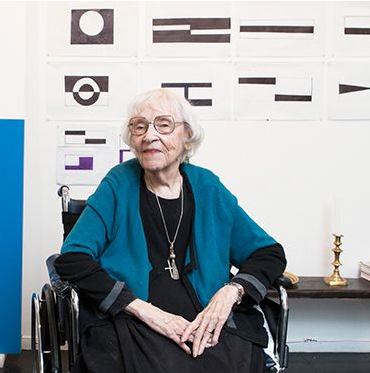article publié le 1 juin 2014
Voici le témoignage de Carmen Herrera (1915-), 99 ans, qui participa au Salon des Réalités Nouvelles de 1948 à 1952, publié dans Blouin Art Info dans un article de Julie Baumgartner le 31/05/14 extrait :
Voici le témoignage de Carmen Herrera (1915-), 99 ans, qui participa au Salon des Réalités Nouvelles de 1948 à 1952, publié dans Blouin Art Info dans un article de Julie Baumgartner le 31/05/14 extrait :
 |
| Black and White 1952 présenté aux Salons des Réalités Nouvelles de 1952 aujourd'hui au MOMA ! |
Le tableau Black and White de 1952, fait d'un jeu optique de lignes noires et blanches qui forment des triangles, est aujourd'hui présenté au Moma de New York. De 1949 à 1952, les oeuvres de Carmen Herrera étaient présentés au Salon des Réalités Nouvelles, une sélection de l'abstraction en Europe. Cette participation a été un tournant pour Herrera.
" Pour participer au Salon des Réalités Nouvelles, on devait apporter son tableau a un groupe de personnes* qui décident si ils le prennent ou non" explique-t-elle, "Je suis allée montrer mon travail, et le type a dit : "Je l'aime beaucoup, madame. Il y a tant de peintures ici, et trop dans chaque."
Et cela a été pour moi, le début d'un processus d'éveil."
Herrera et Lowenthal (son mari) ont vécu à Paris de 1948 à 1953. A Paris, le couple sympathisait avec Jean-Paul Sartre et Simone de Beauvoir, et faisait visiter la ville à Mark Rothko. "Je n'ai jamais rencontré quelqu'un d'aussi dépressif" dit Herrera de Rothko; "On a tout essayé ! L'emmener au théâtre, à diner, à notre maison pour lui montrer comment vivait un artiste; aucune réaction. Il semblait complètement déprimé."
" Pour participer au Salon des Réalités Nouvelles, on devait apporter son tableau a un groupe de personnes* qui décident si ils le prennent ou non" explique-t-elle, "Je suis allée montrer mon travail, et le type a dit : "Je l'aime beaucoup, madame. Il y a tant de peintures ici, et trop dans chaque."
Et cela a été pour moi, le début d'un processus d'éveil."
Herrera et Lowenthal (son mari) ont vécu à Paris de 1948 à 1953. A Paris, le couple sympathisait avec Jean-Paul Sartre et Simone de Beauvoir, et faisait visiter la ville à Mark Rothko. "Je n'ai jamais rencontré quelqu'un d'aussi dépressif" dit Herrera de Rothko; "On a tout essayé ! L'emmener au théâtre, à diner, à notre maison pour lui montrer comment vivait un artiste; aucune réaction. Il semblait complètement déprimé."
De retour à New York, Willem de Kooning, Philip Pavia, Newman et Rothko " n'avaient aucune réaction à mon travail" dit-elle. "J'aimais pas trop ce qu'ils faisaient. Ils ne voulaient pas savoir ce que je faisais. Une Cubaine ? Une femme ? Pfeuh ..."
* (note indicative des Cahiers des RN2,14 : le président du Jury devait être Auguste Herbin entouré de del Marle, Lempereur-Haut, Fontene, Pevsner, Valensi…)
Extrait de la V.O :
 |
| extrait de la photo de Kristine Larsen |
(…) Carmen Black and White, 1952, optical black-and-white stripes that form triangles, now held by the Museum of Modern Art in New York. From 1949
to 1952, Herrera’s work was included in the Salon des Réalités Nouvelles, a juried survey of abstraction in Europe. Participation was a turning point for Herrera. “In order to be in Réalités Nouvelles, you had to bring your work to a group of people who would decide if they will take it or not,” she explains. “I went to show the work, and this guy said, ‘I like it very much, madame. There are many paintings here, but there is too much in one painting.’ And that was the beginning of the awakening process.”
Herrera and Lowenthal lived in Paris from 1948 to 1953. (…) In Paris, the couple socialized with Jean-Paul Sartre and Simone de Beauvoir and showed American friends like Mark Rothko around town. “I’ve never met anyone so depressed" Herrera says of Rothko. “We tried everything! Take him to the theater, to dinner, to our house to show him how an artist lived—no reaction to anything. Completely like he was in black.”
Back in New York, Willem de Kooning, Philip Pavia, Newman, and Rothko “had no reaction to my work” she says. “I didn’t go for what they were doing. They didn’t want to know what I was doing. A Cuban? A woman? Feh.” (…)
Plus si vous êtes intéressé :
http://www.theguardian.com/lifeandstyle/2010/feb/20/carmen-herrera-artist
et un film en préparation : http://alisonklayman.com/carmen-herrera
Nouveau témoignage de Carmen Herrera sur Réalités Nouvelles et Fredo Sidés dans lejournal en ligne de FRIEZE (http://www.frieze.com/issue/article/the-whole-thing/) interview de David Batchelor :
Nouveau témoignage de Carmen Herrera sur Réalités Nouvelles et Fredo Sidés dans lejournal en ligne de FRIEZE (http://www.frieze.com/issue/article/the-whole-thing/) interview de David Batchelor :
DB Your earlier work, in the 1940s, often only used three colours. And it was more informal, perhaps. Did you make a conscious decision one day to say: ‘ok, that’s it, two colours maximum’?
CH In 1948, I was supposed to bring a painting to Fredo Sidès, who was with the Salon des Réalités Nouvelles. He had a beautiful place in Paris. I went there and I showed him my canvas. ‘Ah’, he said, ‘ah, how beautiful’, and so on and so forth. And then he said ‘Madame, we’re going to show it!’ But then he said: ‘One thing; you have many paintings in this painting.’ And I felt very gratified but as I walked away, I realized what he was saying and said to myself: ‘Oh God, what he’s telling me is that I have too much in it.’ He gave me my first big lesson.
